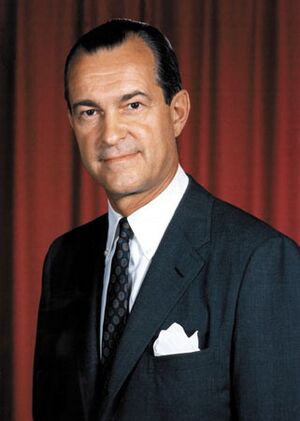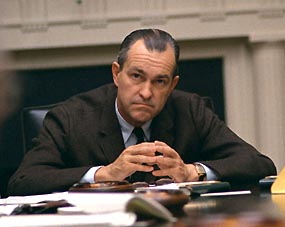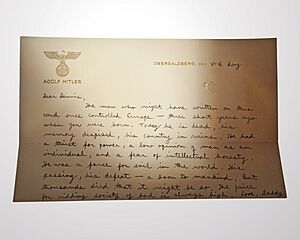Richard Helms facts for kids
Quick facts for kids
Richard Helms
|
|
|---|---|

Official portrait c. 1966–72
|
|
| United States Ambassador to Iran | |
| In office April 5, 1973 – December 27, 1976 |
|
| President | Richard Nixon Gerald Ford |
| Preceded by | Joseph S. Farland |
| Succeeded by | William H. Sullivan |
| 8th Director of Central Intelligence | |
| In office June 30, 1966 – February 2, 1973 |
|
| President | Lyndon B. Johnson Richard Nixon |
| Deputy | Rufus Taylor Robert E. Cushman Jr. Vernon A. Walters |
| Preceded by | William Raborn |
| Succeeded by | James R. Schlesinger |
| 7th Deputy Director of Central Intelligence | |
| In office April 28, 1965 – June 30, 1966 |
|
| President | Lyndon B. Johnson |
| Preceded by | Marshall Carter |
| Succeeded by | Rufus Taylor |
| Deputy Director of Central Intelligence for Plans | |
| In office February 17, 1962 – April 28, 1965 |
|
| President | John F. Kennedy Lyndon B. Johnson |
| Preceded by | Richard M. Bissell Jr. |
| Succeeded by | Desmond Fitzgerald |
| Personal details | |
| Born |
Richard McGarrah Helms
March 30, 1913 St. Davids, Pennsylvania, U.S. |
| Died | October 23, 2002 (aged 89) Washington, D.C., U.S. |
| Resting place | Arlington National Cemetery |
| Relations | Gates W. McGarrah (grandfather) |
| Education | Williams College (BA) |
| Military service | |
| Allegiance | |
| Branch/service | |
| Years of service | 1942–1946 |
| Battles/wars | World War II |
Richard McGarrah Helms (born March 30, 1913 – died October 23, 2002) was an American government official. He was the head of the Central Intelligence Agency (CIA) from 1966 to 1973. He also served as the United States Ambassador to Iran.
Contents
Early Life and Education
Richard Helms was born and grew up in Pennsylvania. He went to a school in Switzerland called Institut Le Rosey, where he learned to speak French and German. After returning to the United States, he graduated from Williams College in Massachusetts.
Career in Intelligence
After college, Helms worked as a journalist in Europe and for a newspaper in Indianapolis. When America joined World War II, he joined the United States Navy. He was then asked to join the Office of Strategic Services (OSS), which was a special group that gathered information during the war. He worked for the OSS in Europe.
After the war, the OSS was closed. Helms continued his intelligence work with new groups like the Strategic Services Unit (SSU) and the Office of Special Operations (OSO). During this time, he focused on gathering information in central Europe as the Cold War began. The OSO later became part of the Central Intelligence Agency (CIA) when it was created in 1947.
In 1950, General Walter Bedell Smith became the head of the CIA. He combined different parts of the CIA to create a new unit for special operations. Helms became the Chief of Operations for this new unit from 1952 to 1958.
Later, during President John F. Kennedy's time, Helms became the Deputy Director for Plans. He helped manage the CIA's part in a big effort to deal with Fidel Castro in Cuba. During the Cuban Missile Crisis, Helms supported the CIA's head, John McCone, who gave important ideas during the discussions at the White House. After President Kennedy was assassinated, Helms helped the CIA with the investigation by the Warren Commission.
Leading the CIA
In June 1966, Richard Helms was chosen to be the Director of Central Intelligence (DCI). This meant he was the main leader of the CIA. He was sworn into his new role by President Lyndon B. Johnson. Helms was the first CIA Director who had started at a lower level in the agency and worked his way up to the top.
Helms served as DCI under President Johnson and then continued in this role through President Richard Nixon's first term, until 1973.
Ambassador to Iran
In late 1972, President Nixon appointed Helms to be the United States Ambassador to Iran. An ambassador is a top diplomat who represents their country in another country.
During his approval hearings in 1973, Helms was asked about the CIA's past actions in Chile. Because these operations were secret, Helms gave answers that were not fully complete. Later, in 1975, new information came out that showed his earlier statements were not entirely accurate. In 1977, he accepted a minor charge for not fully explaining things to Congress. He received a suspended sentence and a small fine.
Later Years
After leaving government service in 1977, Helms was interviewed many times by journalists and authors. He always spoke carefully about his time in the CIA.
In 1977, after returning from Iran, Helms started his own international consulting company called Safeer. The name "Safeer" means "ambassador" in Persian. His company helped people from Iran do business in the United States.
In 1983, President Ronald Reagan gave Helms the National Security Medal. This award is given to people who have done great things for the security of the United States. Helms also helped on the President's Commission on National Security that year.
Helms eventually wrote his own book about his life in the CIA, called A Look Over My Shoulder: A Life in the Central Intelligence Agency. It was published after he passed away in 2003.
Death
Richard Helms died on October 23, 2002, at the age of 89. He was buried at Arlington National Cemetery in Virginia.
Personal Life
In 1939, Richard Helms married Julia Bretzman Shields. Julia had two children from a previous marriage, James and Judith. Richard and Julia had a son together named Dennis. Dennis briefly worked at the CIA before becoming a lawyer. Richard and Julia's marriage ended in 1967. Later, Helms married Cynthia McKelvie, who was from England.
Helms enjoyed reading spy novels for fun. However, he reportedly did not like the famous novel The Spy Who Came in from the Cold by John le Carré. He felt the book showed too much cynicism and betrayal, which he believed was not good for intelligence work. He thought trust was very important.
In May 1945, while working as an intelligence officer in Europe, Helms wrote a letter to his three-year-old son, Dennis. He used paper he found in Adolf Hitler's office in Berlin. He dated the letter on Victory in Europe Day (May 8, 1945), the day Germany surrendered in World War II. Many years later, in 2011, Dennis Helms gave the letter to the CIA, where it is now kept in their museum.
Richard Helms was not related to the U.S. Senator Jesse Helms.
In Media
Richard Helms's life and career have inspired characters in movies and TV shows:
- In the 1977 TV show Washington: Behind Closed Doors, the character William Martin was loosely based on Helms.
- Actor Sam Waterston played Helms in a scene from the 1995 movie Nixon.
- The character Richard Hayes, played by Lee Pace in the 2006 film The Good Shepherd, was also loosely based on Helms.
See also
- Tennent H. Bagley
- Desmond Fitzgerald
- Roscoe Hillenkoetter
- Thomas Karamessines
- Sidney Souers
- Hoyt Vandenberg



